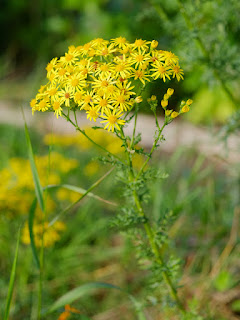Mare's Fart
It has a number of common names... Ragweed; St. James-wort; Stinking Nanny; Stinking Willy; Staggerwort; Dog Standard; Cankerwort; Stammerwort; Cushag and of course, Mare's Fart.
In the UK, Ragwort provides a home and food source to at least 77 insect species, most notably the Cinnabar Moth. Thirty insect species rely on ragwort exclusively as their food source. There are another 22 species where ragwort forms a significant part of their diet. Furthermore, English Nature identifies a further 117 species that use ragwort as a nectar source whilst travelling between feeding and breeding sites. These consist mainly of solitary bees, hoverflies, moths and butterflies.
So why has Ragwort got such a bad reputation? Well, although it has been used as a medicinal remedy by humans for centuries, it is poisonous in larger doses. Horses are perhaps the most at risk. If eaten in sufficient quantities, then it can kill them. It can also be sought out by cows, who become addicted to it causing them to ingest more, but is less of an issue for sheep and goats. This has led the horse community in particular, as well as some farmers, dubious 'experts' and even Defra*, to denounce the plant and spread mis-information about it.
Apart from grazing animals then, it's more beneficial than harmful to the environment. It is also a native plant. That's why so many native insects depend on it. It's also still used as a herbal remedy. The contemporary uses for Ragwort are mainly external for burns, inflammations of the eye, and also in sores and ulcers. A poultice can be used for gout, arthritis and alleviates pain from bee stings. It has been taken in the past as a herbal tea for coughs and even given to teething babies.
I'm not suggesting that we all go and plant some, or that we encourage it to spread, as there's plenty of it around already this year. But, since there are no livestock down the allotments (just as well since they can also be poisoned by brassicas), it's not something we need to dig up and burn right now. In fact, there is no law in the UK forcing anyone to remove Ragwort from their land, but you can be prosecuted for removing it from someone else's. Like any wild plant, please don't uproot it if you see it growing wild. You are breaking the law.
If we got rid of every potentially poisonous plant then the diversity of our environment would be harmed, not helped. Sweet Peas, Rhubarb leaves, Foxgloves, Daffodils, even Potato and Tomato leaves are all more poisonous than Ragwort, yet are found in abundance on the allotment site. It's estimated you'd need to eat 5-20% of your body weight to be killed by Ragwort as it's only mildly toxic to humans, so I'm advising against jumping on the toxic plant bandwagon. Just like a mare's fart, it's unlikely to kill you!
*Defra has recently withdrawn its guidance for controlling Ragwort.
In the UK, Ragwort provides a home and food source to at least 77 insect species, most notably the Cinnabar Moth. Thirty insect species rely on ragwort exclusively as their food source. There are another 22 species where ragwort forms a significant part of their diet. Furthermore, English Nature identifies a further 117 species that use ragwort as a nectar source whilst travelling between feeding and breeding sites. These consist mainly of solitary bees, hoverflies, moths and butterflies.
So why has Ragwort got such a bad reputation? Well, although it has been used as a medicinal remedy by humans for centuries, it is poisonous in larger doses. Horses are perhaps the most at risk. If eaten in sufficient quantities, then it can kill them. It can also be sought out by cows, who become addicted to it causing them to ingest more, but is less of an issue for sheep and goats. This has led the horse community in particular, as well as some farmers, dubious 'experts' and even Defra*, to denounce the plant and spread mis-information about it.
Apart from grazing animals then, it's more beneficial than harmful to the environment. It is also a native plant. That's why so many native insects depend on it. It's also still used as a herbal remedy. The contemporary uses for Ragwort are mainly external for burns, inflammations of the eye, and also in sores and ulcers. A poultice can be used for gout, arthritis and alleviates pain from bee stings. It has been taken in the past as a herbal tea for coughs and even given to teething babies.
I'm not suggesting that we all go and plant some, or that we encourage it to spread, as there's plenty of it around already this year. But, since there are no livestock down the allotments (just as well since they can also be poisoned by brassicas), it's not something we need to dig up and burn right now. In fact, there is no law in the UK forcing anyone to remove Ragwort from their land, but you can be prosecuted for removing it from someone else's. Like any wild plant, please don't uproot it if you see it growing wild. You are breaking the law.
If we got rid of every potentially poisonous plant then the diversity of our environment would be harmed, not helped. Sweet Peas, Rhubarb leaves, Foxgloves, Daffodils, even Potato and Tomato leaves are all more poisonous than Ragwort, yet are found in abundance on the allotment site. It's estimated you'd need to eat 5-20% of your body weight to be killed by Ragwort as it's only mildly toxic to humans, so I'm advising against jumping on the toxic plant bandwagon. Just like a mare's fart, it's unlikely to kill you!
*Defra has recently withdrawn its guidance for controlling Ragwort.
Submitted by Tigger

Comments
Post a Comment